Editor’s note: A version of this story, by the late Cameron Beach and MSR President Rick Laubscher, appeared in a 2003 issue of Inside Track, our member magazine with exclusive stories and inside information about Muni’s historic streetcars and cable cars. Click here to become a member and receive it.
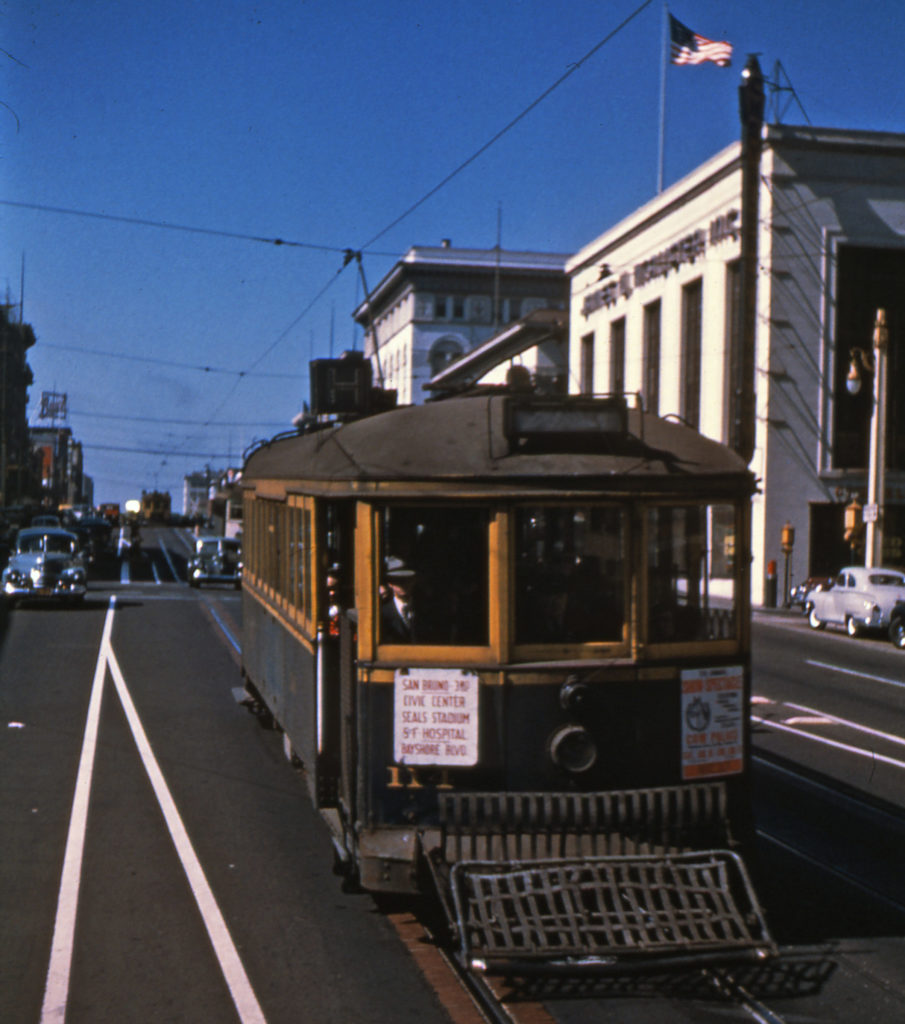
Many streetcar fans believe it was all a plot by fiendish bus builders, tire makers, and fuel providers, forming an illegal conspiracy to rob America of its beloved streetcars after World War II. That conspiracy is why we have so few lines left in San Francisco, they say.
In that time period, so–called “rubber tire interests” did indeed form a company called National City Lines that went around the country buying up private streetcar companies and converting them to bus operation. The buses, tires, and fuel usually came from the companies that owned National City. One such property, in fact, was the East Bay’s Key System. But, even at the national level, this conspiracy theory leaves out lots of realities. Private transit operators failing financially, with no capital to replace worn–out streetcars and track. The baby boom, spurring the development of suburbs well beyond the reach of existing streetcar lines. The flat–out preference of most who could afford it for the automobile, especially after the sacrifices made during the war.
Some of these national factors did impact Bay Area transit. Other factors that shaped San Francisco’s streetcar story were unique.
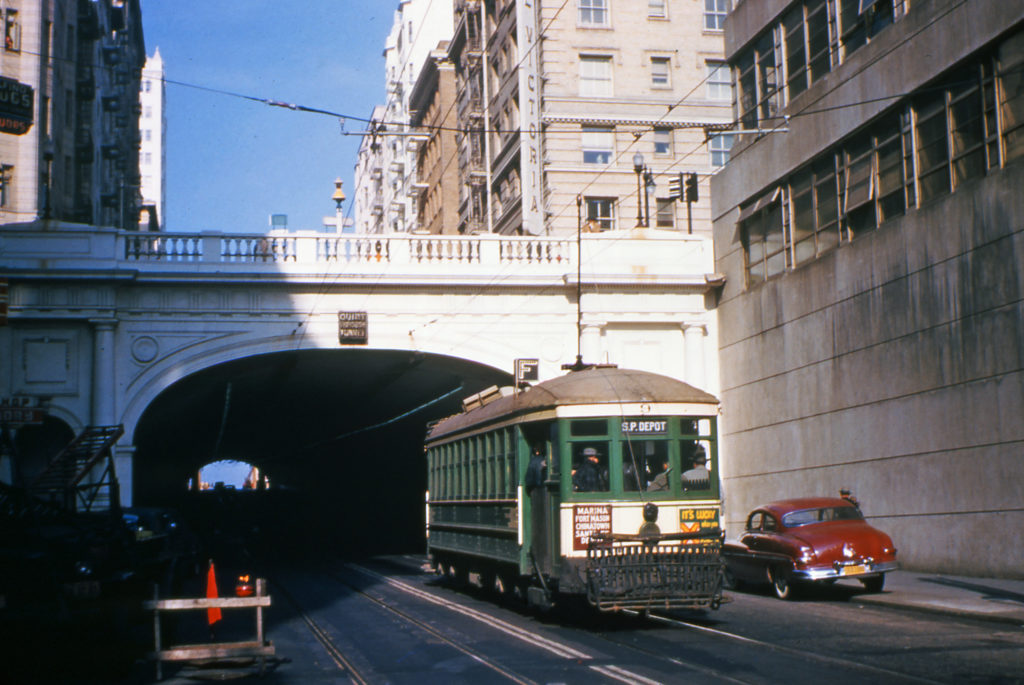
San Francisco’s two major transit systems merged in 1944, when, after numerous failed attempts, voters finally approved a bond issue to allow publicly owned Muni to buy out the larger, private Market Street Railway Company (referred to here as “MSRy” to distinguish it from our organization, “MSR”). The strains of heavy wartime demand were apparent on the cars and tracks of both systems, especially MSRy, which had endured hard financial times well before the war and was not making any significant capital investments in its infrastructure.
As the war neared its end, the City’s transit system was falling apart. Muni owned only five modern streetcars, bought in 1939, out of a combined fleet of almost 500. Most of those cars were completely worn out, as was much of the track and overhead wire they ran on.
The Newton plan
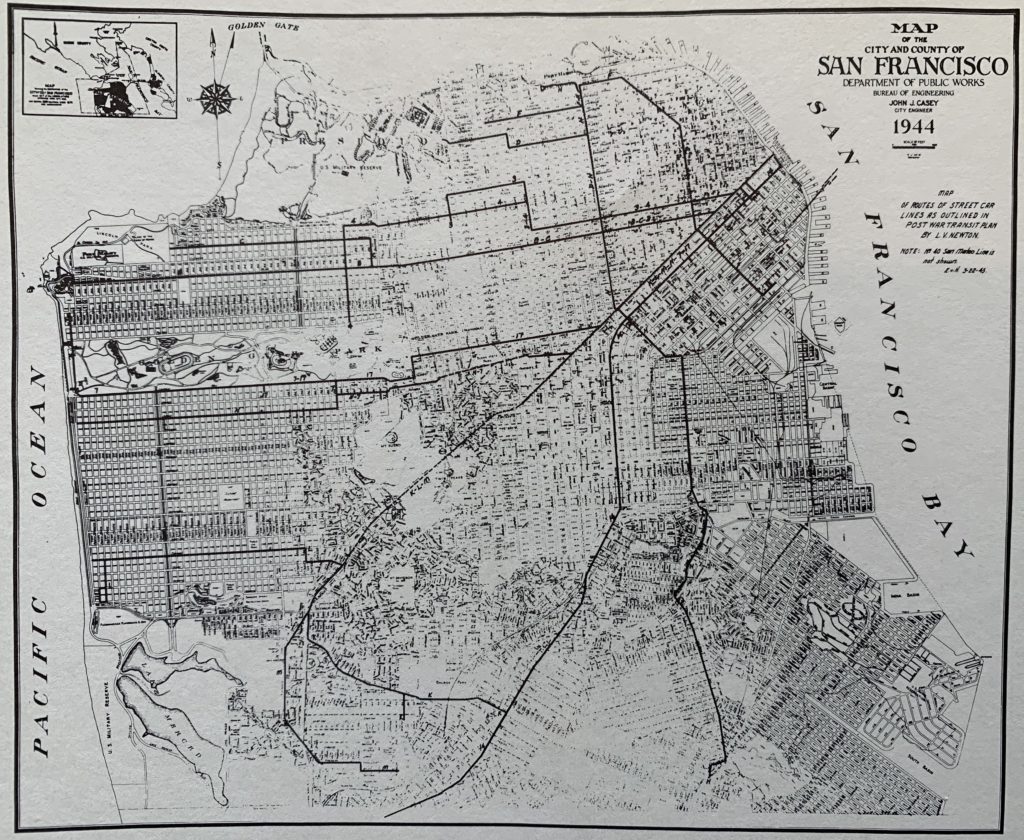
Muni management knew it needed to modernize once the war ended, so in early 1945, it commissioned a plan for postwar operation from consulting engineer Leonard Newton, a former vice president of MSRy. He understood the poor condition of the cars and track and recommended converting half the existing streetcar lines to trolley coach or motor coach operation, including the J-Church. However, he did advocate retaining fifteen streetcar routes and reequipping them with modern “PCC” type streamline streetcars (as now run on the F-line). These included nine Muni lines: the B, C, and D, which used Geary, the K, L, M, and N, which all used tunnels too small for buses, the F-Stockton and the H-Potrero, which ran on Van Ness Avenue. Also included were six ex–Market Street Railway lines: 3-Jackson, 4-Sutter, 7-Haight (rerouted via the Sunset Tunnel), 14-Mission, the inner section of the 17-Haight/Parkside line, and the 40 interurban line to San Mateo. All in all, Newton recommended buying 313 new PCC streetcars, which would have been a huge order.
However, while Newton’s report laid out the costs of buying the new vehicles and reconstructing the track, it did not include operating costs, a critical omission. As he predicted in his plan, the end of gasoline rationing sent many Muni riders back to their automobiles again. Even with a fare increase, Muni’s finances were rapidly deteriorating at a time when transit systems were still expected to make a profit.
Two–person crews
San Francisco required crews of two on streetcars and cable cars, though only one on buses. With the merger, Muni now had two powerful operator’s unions to deal with: its own and the one that still represented ex–MSRy motormen and conductors. Both unions were staunchly opposed to reducing crew size, which would have required a City Charter amendment approved by the voters in any event. So Newton repeatedly stated in his report that the new PCCs would be modified for operation by two–person crews, even though a major reason the transit industry designed the PCC in the first place, some ten years earlier, was to cut labor costs in half by only requiring a single operator per car.
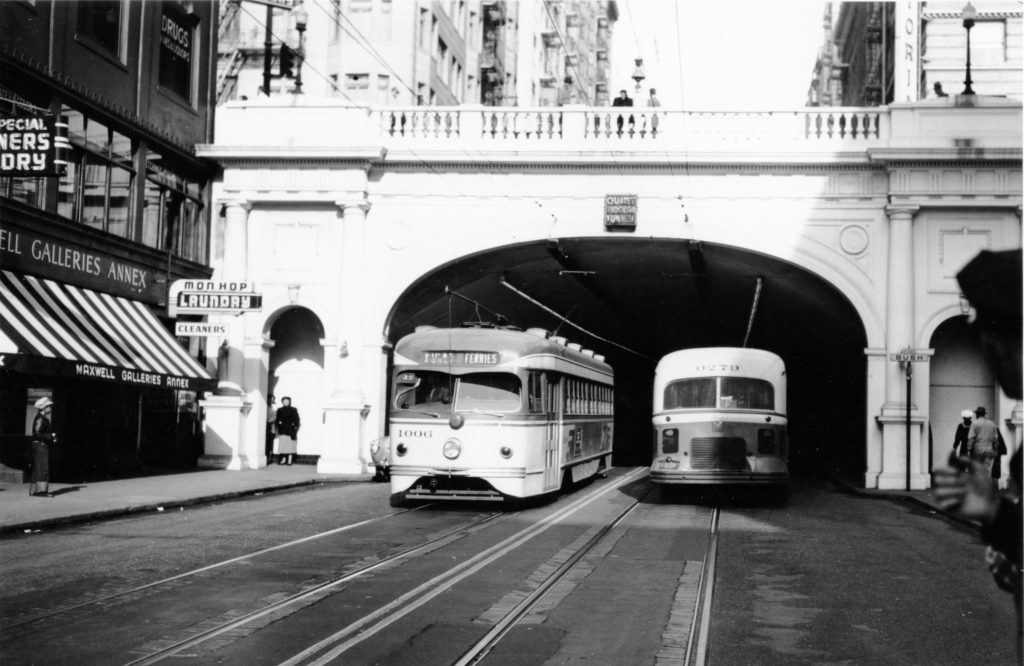
Two years after Newton’s plan came out, the City worked up another plan in conjunction with a $20 million bond issue to modernize Muni. By this time, the proposed vehicle mix had tilted sharply toward buses. The labor cost differential clearly played a major part. The bond issue passed, but the money was almost all spent on hundreds of new trolley coaches and motor coaches used to convert former streetcar lines. Had there been enough money right after the war to buy a full fleet of PCC cars, at least for the core streetcar lines, the public might have embraced their comfort and speed and insisted on retention of more streetcar lines. However, with two–man PCC streetcars costing double the operating cost of a one–driver bus of similar capacity, there was no management incentive to buy large numbers of new streetcars.
What the public saw instead at the end of the 1940s was a fleet of new trolley coaches and motor coaches with upholstered seats and effective heaters running on smoothly repaved streets, replacing noisy, drafty, old streetcars with hard seats often bouncing along on bad track.
A few new streetcars
Muni did manage to find enough money from another source to buy ten modern streetcars, its first true PCCs, in 1948. These cars, numbered 1006-1015, were double–ended and set up for two–person crews. (Thanks in large part to persistent advocacy by MSR, seven of these cars, which later came to be known as “torpedoes” for their shape, were preserved, then fully restored, and are in Muni’s vintage streetcar fleet today.)
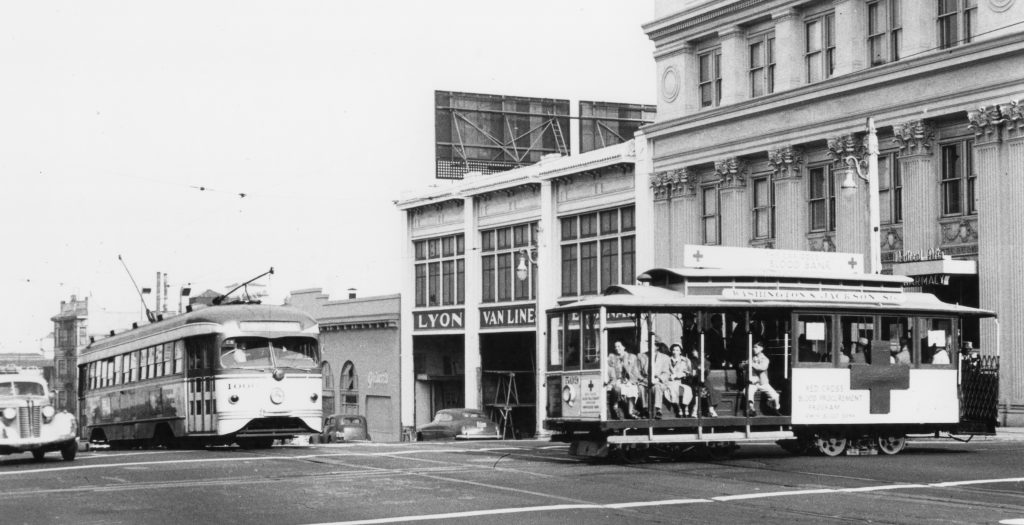
Added to the five 1939 “Magic Carpet” cars, which were almost identical in appearance, Muni now had fifteen modern cars. Had they been deployed strategically on a line where it was not final whether streetcars would stay or go, they might have made a difference. Instead, however, in that critical period from 1948-1951, the modern cars were concentrated on two tunnel lines, the L and N, neither of which was in danger of conversion. In fact, the original destination signs of the 1948 double-enders indicate that decisions had already effectively been made. Though the D-Van Ness, F-Stockton, and H-Potrero all were recommended for continued streetcar service in the Newton Plan, and lasted into 1950 or 1951, none of those routes appears on the original 1948 roll signs of the “torpedoes”.
Some elements of the Newton plan had, by this time, been put into effect. The F-Stockton line (today’s 30-line trolley bus), which ran from the Marina through North Beach and Chinatown, reaching downtown through the Stockton tunnel, was connected to old MSRy tracks at Fourth and Market
to reach the Southern Pacific train depot, then at Third and Townsend Streets, but still using the original narrow 1912 Muni A-type” streetcars (including at times, preserved Car 1). The H-line, which ran from Fort Mason south on Van Ness, 11th Street and Potrero Avenue to Army Street, was tied in there to the old Market Street Railway 25-line on San Bruno Avenue to reach all the way to the Portola District.
Streetcars slip away on the F and H
In the various plans coming forth right after the war, the F and H lines were generally marked for retention; thus the investment in the extensions. But most of the original H-line route, on Van Ness and Potrero, was also US 101, and the State Division of Highways had a big say in what happened on those streets. With plans being made for heavy residential development in Marin County across the Golden Gate Bridge, it seemed certain that automobile demands on Van Ness would increase rapidly. Some grumbled that streetcars stopping frequently in the “fast” lane of the broad street would hold up automobiles. Running the modern streetcars on Van Ness might have counteracted this pressure somewhat, but there was resistance in Muni to using its newest cars on the beat up track on the outer end of the ex–MSRy route along San Bruno Avenue.
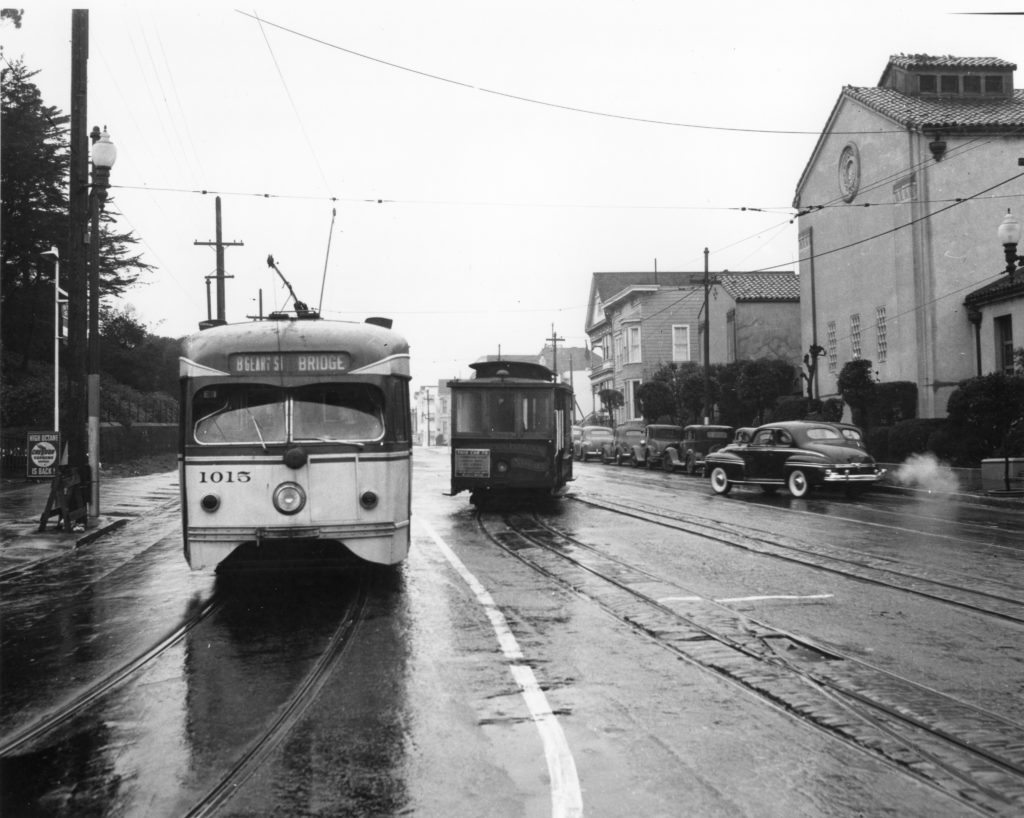
The F-Stockton posed a different problem. Muni’s new streetcars were wide, but the F-line used Muni’s oldest “A-type” cars because they were also its narrowest, and could more easily squeeze past the delivery trucks on the commercial streets that made up most of the route. Trolley coaches, not stuck on rails, could at least swing around traffic that got in their way, and on Stockton Street, especially in Chinatown, that came to be seen as an appealing alternative, especially when F-line riders were still using 1912–vintage streetcars.
Streetcars saved on the J and M
The Muni had enough trolley coaches to convert the F-Stockton but ran out of money to convert the J-Church. The J-line streetcar ran (and still runs) on a scenic private right–of–way to negotiate steep Dolores Heights, but it didn’t have tunnels that protected the K, L, M, and N. J-line ridership was lower than either the F or H and trolley coaches could easily handle the grades involved. Muni tried again in 1952, with a ballot measure providing bond funding to convert the J to trolley coaches, along with the busy B and C on Geary. A majority of voters approved, but it fell short of the needed two-thirds, so the J stayed a streetcar.
A 1948 plan by engineering firm DeLeuw Cather recommended upgrading the M-Ocean View streetcar into a rapid transit line, one of several attempts to add capacity to the M over the decades. The stunning aspect of that plan, however, was a grid of freeways beyond even what the State Division of Highways later proposed (and which caused the historic “freeway revolt” of the late 1950s and 1960s). The car was queen in this plan; surface transit the ugly stepchild.
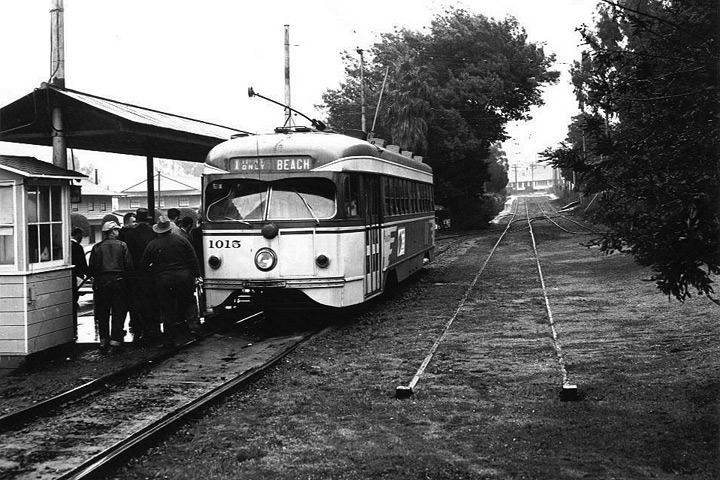
Looking back, there were many factors combining to truncate San Francisco’s streetcar system after World War II. But the requirement for two crew members, even on modern streetcars, clearly played a dominant role. In a 1949 report on the Muni to the Board of Supervisors, consulting engineer Arthur Jenkins noted, “Almost every city in the country that still continues to operate streetcar service uses one–man cars with the notable exception of San Francisco.” He went on to state “it has been generally true throughout the industry that use of one–man cars has not been adopted primarily as a means of increasing profits to owners, but as a means of remaining in business at all.”
But rail restoration dreams have never died, and there have been successes, most notably with the T-line from Visitacion Valley to downtown, which opened in 2007, running mostly along the old 16-line MSRy route along Third Street. Its original downtown alignment was to continue under Third and Kearny Streets to reach downtown and Chinatown (as the 16-line did on the surface). Instead, it was shifted westward to run under Fourth and Stockton Streets, like the final alignment of Muni’s old F-Stockton line. That alignment opened as the Central Subway in 2022.
Other rail dreams have not been realized, though. Restoring rail service to Van Ness Avenue, for example, either in a subway or on the surface, gave way to a drawn-out bus rapid transit project that opened after 20 years of planning and construction in 2022. The biggest rail restoration dream of all, along Geary, also seems dead, as that corridor moves fitfully toward bus rapid transit as well. In this related post, we look at the 1950s fight to the death over the Geary streetcar lines, and examine the attempts to bring rail back there.
We depend on your support to keep telling these stories of how transit built today’s San Francisco. Please consider supporting us. Thanks.